The two sites
We begin with descriptions of the two sites.
Agiasmatsi
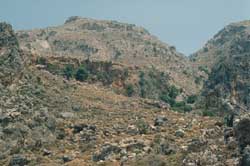 Agiasmatsi Cave, looking N up at the site (centre left, marked by large carob tree). July 1990. © Sphakia Survey |
The cave, at 296m, is on the west side of a small, unnamed gorge that cuts the steep limestone hills rising up from the Frangokastello plain.
 Looking south over site from Agiasmatsi cave over the Frangokastello plain. Ag. Astratigos lies on the far right. © Sphakia Survey |
The cave was no doubt always known to locals, but it was officially ‘discovered’ only in 1963 by speleologists, on the basis of information from Aristotelis Phoukarakis, the teacher at Patsianos. They dutifully deposited their finds in the Khania Museum. Paul Faure visited the cave in 1965 and 1966 and deposited a stone blade and other items in the museum. Subsequent finds, looted in 1967, turned up in the Sitia area, but in 1968 Ioannis Tsiphetakis, a speleologist, deposited further finds in the Khania Museum. The cave has been studied by Tyree, and by Rutkowski and Nowicki. Our first visit, in 1990, was made possible by the guidance of Andreas Daradoulis from Kapsodasos (now normally resident in Athens); because of the richness of the material, we visited the site again in 1992. Total sherds collected: 500.
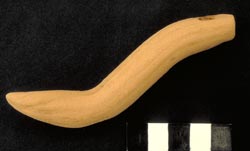 Agiasmatsi Cave: ladle handle. © Sphakia Survey |
The entrance is low, but opens into a front chamber with a platform with stalactites and stalagmites on the left. On the right is a narrow passage to a large chamber with more stalactites and stalagmites.
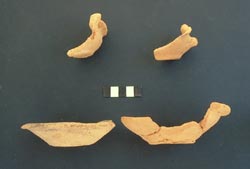 Agiasmatsi Cave: Side view of full profile ladles. © Sphakia Survey |
At the back of the large chamber the roof and floor converge to form a small sinkhole where stone and many sherds (densities of more than 50 seen by us) were collected.
 Reconstruction drawing of ladle, from Agiasmatsi Cave. © Sphakia Survey |
The site used to be thought of a Prehistoric cave sanctuary, rich in alleged bulls’ horns and phalluses, but work here conducted by the Sphakia Survey shows that the site was in fact used for ritual purposes much later, primarily in the Hellenistic and early Roman periods.
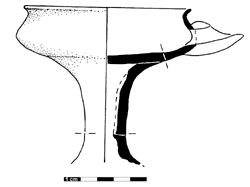 Reconstruction drawing of lamp, from Agiasmatsi Cave. © Sphakia Survey |
It is also marked by two types of artefacts which are rare or even unique to this site: multiple-nozzle lamps and ladles (whose handles constitute the alleged horns and phalluses!).
Agios Astratigos
Large Roman-Late Roman settlement in the middle of Frangokastello plain, with many (plannable) walls, stone, and sherds. Height: rock piles 16-24, scatters 14-24. View over whole plain. Limestone conglomerate; soil red sandy silt. Garigue 25%; steppe 10%; maquis 5%; rock 15%; soil 15%. Visibility: good. Now much browsing (2 mandras); sinuous enclosure walls marking Mediaeval phase.
 Ag. Astratigos looking NE, empty field on left, site with church on right in carob grove. Church marked by one standing white marble column. (Sept 2000) © Sphakia Survey |
The site is distinctive for its numerous stone piles, many marked by huge carob stools (up to 1000-years old?). Maximum size (rock piles, judged by extent of trees on aerial): 320 x 130m; (pottery scatter) 360 x 250m. E side of site: coursed perimeter wall, width 1.20m, stones 30 x 25 x 15cm. Few visible traces of ancient walls, but at NE end of site: ‘dressed’ stone wall with 2 corners (Z shape), breccia with limestone mortar.
 Ag. Astratigos: view of exterior N wall, showing original wall, remains of original apse, later N wall with scaffolding holes, Simon Price marks original N wall, Lucia Nixon the original E wall, looking SE. (July 1990) © Sphakia Survey |
Late Roman Christian basilica, internal dimensions 19m x 12.40m without apse; internal colonnades (one column footing visible), door on N side, and narthex; door in N wall. Line on N wall shows end of each day's work. Basilica probably dates to sixth century.
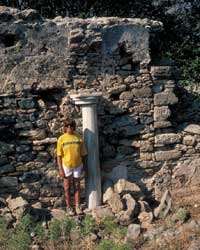 Ag. Astratigos: June 1987: Julie Clark to left of Late Roman column reused in (now ruined) Medieval chapel. Looking north. © Sphakia Survey |
Basilica ‘cut down’ at in the Mediaeval period, and frescoes of geometric patterns added. One monolithic column of Proconnesian marble (2.05m tall) and base reused in Mediaeval chapel and pieces of at least four other columns nearby; all presumably from original Late Roman basilica.
The later church is long ruined, and poor quality walls were built to turn basilica into mandra. But even so everyone locally is sure that its name is Agios Astratigos, that is Michael the Archangel. Note how the advent of Christianity to this area meant a major change in the conception of sacred space (not caves, but buildings).
The site must be a Roman/Late Roman nucleated settlement, with numerous houses. The basilica seems large for the likely population of this site. Either the site must have been a monastic settlement (with a prestigiously large basilica), or the church had a wider appeal within the Frangokastello area. Though the Late Roman pottery goes late (perhaps into the eighth century), we saw no Byzantine pottery, and the age of the carobs on the stone piles (?up to 1000 years) suggests abandonment of the houses by the turn of the millennium; the basilica must also have fallen into ruins, so at to be ‘cut down’. According to local legend, the site was originally called Patsianos (after a certain Patsos), and was ruined by Saracen and Algerian pirates. When the Frangokastello fort was built in the fourteenth century (see Unit 4 Session 3 Lesson 1 for further details), the plain itself seems not to have been inhabited.
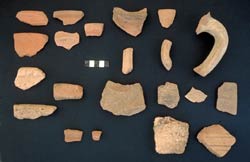 Ag. Astratigos Roman-Late Roman sherd assemblage © Sphakia Survey |
Sherds predominantly Roman-Late Roman (second to seventh or even eighth century), good-sized with well-preserved surfaces (total collected: 202).
Generally domestic assemblage, but little cooking ware: Fine (African Red Slip; Phocaean Red Slip); Common; Cooking; Storage; Amphora; Tile; Beehive.
We can illustrate three of our categories of pottery here:
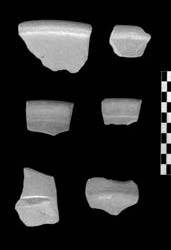 Ag. Astratigos: imported Decorated Table Wares: African Red Slip rim; Phocaean Red Slip rim; African Red Slip bowl; African Red Slip rim; African Red Slip base. © Sphakia Survey |
Fine Wares include a good range of imported table ware, from Africa and western Turkey.
 Ag. Astratigos. Amphoras: North African handle; Cretan handle; Aegean bodysherd; wavy combed bodysherd; groups of combing. © Sphakia Survey |
Transport and Storage. There are amphoras from various places (including Cretan; N African; Cilician/Syrian; Aegean).
 Ag. Astratigos : jug/jar base; tile © Sphakia Survey |
Special. There is tile from this site.